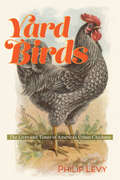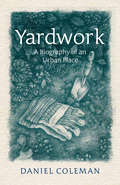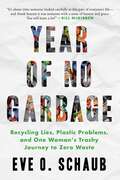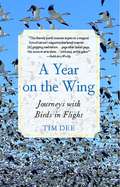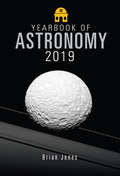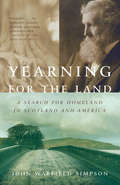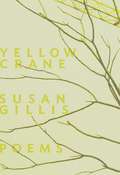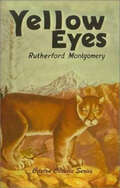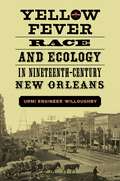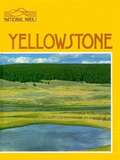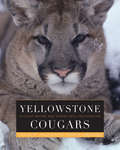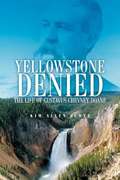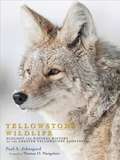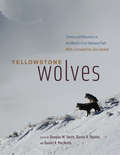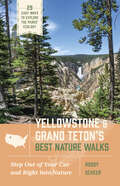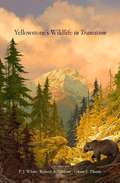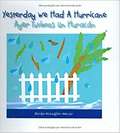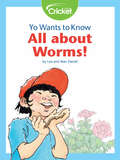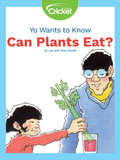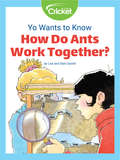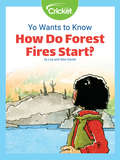- Table View
- List View
Yankee Mission: Thomas Kydd 25 (Thomas Kydd #36)
by Julian Stockwin'Yankee Mission is a jewel in Julian Stockwin's crown as a master in naval fiction, with a ship-to-ship fight so vivid that the battle's sounds and scents fly off the pages like lethal wooden splinters' - Quarterdeck1812. Off the coast of Brazil, HMS Java, a proud British 38-gun frigate, is captured in battle by the American USS Constitution - signaling across the world's oceans a challenge to Britain's naval premiership that cannot be ignored.Back in EnglandCaptainSir Thomas Kydd is enjoying a moment of normal life with his wife and his newborn son. With his Thunderer in dock receiving some well-earned repairs he is, momentarily, without a command. It's a position the Admiralty does not leave him in for long, and he is soon given a mission: engage the young republic in a fair fight, frigate against frigate, and restore the Navy's reputation. And they have just the ship and crew for him . . . Tyger. But on reaching the US east coast, Kydd and his trusted Tygers realise that the hardest part of their mission will be drawing out one of the Yankee men-o'-war to engage in battle - especially once the Americans get wind of his purpose. It's a tall order, requiring every ounce of the crew's guile and persistence - and when fortune turns against them, Kydd finds not only his career, but his life, hanging in the balance.Praise for Julian Stockwin's Kydd series:'A very readable and enjoyable story . . . I can only recommend that you go out, beg, borrow or buy, and enjoy' - Bernard Cornwell 'In Stockwin's hands the sea story will continue to entrance readers across the world' - Guardian'The characterization is first-class, and the reader quickly becomes involved with all that happens' - Historical Novels Review
Yankee Mission: Thomas Kydd 25 (Thomas Kydd #36)
by Julian StockwinSwashbuckling adventure during the great Age of Sail.With Bonaparte held to a stalemate in Europe, the race to empire is now resumed. Britain's ambitions turn to the Spice Islands, the Dutch East Indies, where Admiral Pellew has been sent to confront the enemy's vastly rich holdings in these tropical islands. Captain Sir Thomas Kydd joins reinforcements to snatch these for the British Crown.The two colonial masters of India and the East Indies face each other in mortal striving for the region - there can be only one victor to hold all the spoils. The colonial genius, Stamford Raffles, believes Britain should strike at the very centre of Dutch spice production, the Moluccas, rather than the fortresses one by one but is fiercely opposed. Kydd, allying himself to this cause, conspires to lead a tiny force to a triumphant conclusion - however the Dutch, stung by this loss, claim vengeance from the French. A battle for Java and an empire in the East stretches Kydd and Tyger's company to their very limits.*************Praise for Julian Stockwin's Kydd series'In Stockwin's hands the sea story will continue to entrance readers across the world' Guardian'Paints a vivid picture of life aboard the mighty ship-of-the-line' Daily Express'This heady adventure blends fact and fiction in rich, authoritative detail' Nautical Magazine'Fans of fast-paced adventure will get their fill with this book' Historical Naval Society(P) 2022 Hodder & Stoughton Limited
Yard Birds: The Lives and Times of America’s Urban Chickens
by Philip LevyIn 2009, the New Yorker declared chickens the "it bird" and heralded "the return of the backyard chicken." This honor occurred as, a host of American cities were changing their laws to allow chickens in residents’ backyards. Philip Levy, a sometime chicken keeper himself, mixes cultural history with husbandry to chronicle the weird and wonderful story of Americans’ urban chickens. From the streets of Brooklyn to council chambers in Albany to the beat of Key West’s Chicken Nuisance Patrol, yard birds are an important and growing part of American city life.Part history, part travelogue, and part reportage, Yard Birds takes the reader on a tour-de-force journey across America, past and present, to profile its urban chickens housed in luxury coops or dying at yearly rituals. What emerges is a compelling picture of city chickens that can both serve as hipster status symbols and guarantee that the families keeping them have at least something to eat. Levy’s smart and entertaining investigation of the contemporary urban chicken craze reveals that poultry flocks were historically an integral part of America’s urban spaces; chickens have simply returned home now, some to very fancy roosts.
Yardwork: A Biography of an Urban Place
by Daniel ColemanShortlisted: 2018 RBC Taylor Prize for Literary Non-fiction How can you truly belong to a place? What does being at home mean in a society that has always celebrated the search for greener pastures? And can a newcomer ever acquire the deep understanding of the land that comes from being part of a culture that has lived there for centuries? When Daniel Coleman came to Hamilton to take a position at McMaster University, he began to ask himself these kinds of questions, and Yardwork: A Biography of an Urban Place is his answer. In this exploration of his garden – which Coleman deftly situates in the complicated history of Cootes Paradise, off of Hamilton Harbour – the author pays close attention to his small plot of land sheltered by the Niagara Escarpment. Coleman chronicles enchanting omnivorous deer, the secret life of water and the ongoing tension between human needs and the environment. These, along with his careful attention to the perspectives and history of the Six Nations, create a beguiling portrait of a beloved space.
Year of No Garbage: Recycling Lies, Plastic Problems, and One Woman's Trashy Journey to Zero Waste
by Eve O. Schaub"Eve&’s brave and honest experiment reveals the shocking impact of the throwaway society we&’ve become and at the same time showing small ways we can all do better.&” —Rebecca Prince-Ruiz, founder of Plastic Free JulyYear of No Garbage is Super Size Me meets the environmental movement. In this book Eve O. Schaub, humorist and stunt memoirist extraordinaire, tackles her most difficult challenge to date: garbage. Convincing her husband and two daughters to go along with her, Schaub attempts the seemingly impossible: living in the modern world without creating any trash at all. For an entire year. And- as it turns out- during a pandemic. In the process, Schaub learns some startling things: that modern recycling is broken, and single stream recycling is a lie. That flushable wipes aren&’t flushable and compostables aren&’t compostable. That plastic drives climate change, fosters racism, and is poisoning the environment and our bodies at alarming rates, as microplastics are being found everywhere, from the top of Mount Everest to the placenta of unborn babies. If you&’ve ever thought twice about that plastic straw in your drink, you&’re gonna want to read this book.
Year on the Wing
by Tim DeeBirds--those "upgiven ghosts" who shape our skies--and their many styles of flying have inspired us for centuries. Enthralled with birds since he was a young boy, Tim Dee describes their allure in compelling, poetic prose as he follows these magnificent creatures on land, at sea, and in the air over the course of a year. A memoir of the author's life as well as a stirring account of bird migrations and the enticements of flight, the book explores the ideas and feelings that birds awaken by their flying. A Year on the Wing is also a significant chronicle of Dee's rich reading of a gorgeous literary and naturalist tradition about birds, and achieves a marvelous commingling of nature and language, finding meaning and a fascinating beauty in the quiver of a redstart's tail, in the thrilling skydiving stoop of the once-endangered now resurgent peregrine falcon, and the nocturnal restlessness of migrant woodcocks. Watching birds instills a renewed sense of wonder in us all, and this beautifully written memoir celebrates birds and the inspiration they give as it expands our horizons.e inspiration they provide through their twice-yearly winged migrations.
Yearbook of Astronomy, 2019
by Brian JonesAn inspiration to amateur and professional astronomers alike, the Yearbook of Astronomy warrants a place on the bookshelf of all sky watchers and stargazers. Maintaining its appealing style and presentation, the Yearbook of Astronomy 2019 contains an authoritative set of sky charts and comprehensive jargon-free monthly sky notes to enable backyard astronomers everywhere to plan their viewing of the years eclipses, comets, meteor showers and deep sky objects.In addition, a variety of entertaining and informative articles present the reader with information on a wide range of topics including, among others, The Cassini-Huygens Mission to the Saturn System; 100 Years of the International Astronomical Union; The First Micro-Quasar; Getting the Measure of Double Stars; Asaph Hall: Man of Mars; and Science Fiction and the Future of Astronomy.The Yearbook of Astronomy has been around for well over half a century and, as it heads towards its Diamond Jubilee edition in 2022, continues to be essential reading for anyone lured by the magic of astronomy and who wants to extend their knowledge of the Universe and the wonders it plays host to.
Yearning for the Land: A Search for the Importance of Place
by John W. SimpsonA beautiful, meditative memoir mixed with travel and history, this unique book is the story of one American's search for a deeper connection to the land. Drawn by a sense that he is missing a critical link to his home in suburban Ohio, John W. Simpson heads for rural Scotland, where he encounters his own family history as well as estate owners and tenant farmers who have centuries-long ties to their land. As he travels, he meditates on the legacy of the great 19th century conservationist John Muir, who himself developed a complex love of the land when he immigrated from Scotland's North Sea coast to the fields and forests of Wisconsin. As Simpson physically retraces Muir's journey he wonders what sense of belonging Muir found on the frontier that modern America, with its strip malls and housing developments, has forgotten. A fascinating story of changing perceptions and values from the Old World to the New, Yearning for the Land shows us just how much roots matter--both in our own lives, and in the many ways time and history, landscape and community are tightly intertwined.From the Trade Paperback edition.
Yellow Crane
by Susan GillisInviting, human, capacious poems that grapple with ideas while also lightly grieving our capacity for ruin.
Yellow Eyes
by Rutherford MontgomeryYellow Eyes raised and faced about. His amber eyes shone and his ears were laid back. In an instant he struck again and sent the leader of the pack hurtling from the cliff. Against dogs, man, and natural enemies the fierce American cougar fights to keep his rule supreme in the high mountain country of the West.
Yellow Fever, Race, and Ecology in Nineteenth-Century New Orleans (The Natural World of the Gulf South #8)
by Urmi Engineer WilloughbyThrough the innovative perspective of environment and culture, Urmi Engineer Willoughby examines yellow fever in New Orleans from 1796 to 1905. Linking local epidemics to the city’s place in the Atlantic world, Yellow Fever, Race, and Ecology in Nineteenth-Century New Orleans analyzes how incidences of and responses to the disease grew out of an environment shaped by sugar production, slavery, and urban development.Willoughby argues that transnational processes—including patterns of migration, industrialization, and imperialism—contributed to ecological changes that enabled yellow fever–carrying Aedes aëgypti mosquitoes to thrive and transmit the disease in New Orleans, challenging presumptions that yellow fever was primarily transported to the Americas on slave ships. She then traces the origin and spread of medical and popular beliefs about yellow fever immunity, from the early nineteenth-century contention that natives of New Orleans were protected, to the gradual emphasis on race as a determinant of immunity, reflecting social tensions over the abolition of slavery around the world.As the nineteenth century unfolded, ideas of biological differences between the races calcified, even as public health infrastructure expanded, and race continued to play a central role in the diagnosis and prevention of the disease. State and federal governments began to create boards and organizations responsible for preventing new outbreaks and providing care during epidemics, though medical authorities ignored evidence of black victims of yellow fever. Willoughby argues that American imperialist ambitions also contributed to yellow fever eradication and the growth of the field of tropical medicine: U.S. commercial interests in the tropical zones that grew crops like sugar cane, bananas, and coffee engendered cooperation between medical professionals and American military forces in Latin America, which in turn enabled public health campaigns to research and eliminate yellow fever in New Orleans.A signal contribution to the field of disease ecology, Yellow Fever, Race, and Ecology in Nineteenth-Century New Orleans delineates events that shaped the Crescent City’s epidemiological history, shedding light on the spread and eradication of yellow fever in the Atlantic World.
Yellowstone
by Carol MarronDescribes the geography, including the geysers, hot springs, mud pots, and fumaroles, and plants and animals of Wyoming's Yellowstone Park. Includes a history of the park.
Yellowstone Cougars: Ecology before and during Wolf Restoration
by Toni K. Ruth Polly C. Buotte Maurice G. HornockerYellowstone Cougars examines the effect of wolf restoration on the cougar population in Yellowstone National Park—one of the largest national parks in the American West. No other study has ever specifically addressed the theoretical and practical aspects of competition between large carnivores in North America. The authors provide a thorough analysis of cougar ecology, how they interact with and are influenced by wolves—their main competitor—and how this knowledge informs management and conservation of both species across the West. Of practical importance, Yellowstone Cougars addresses the management and conservation of multiple carnivores in increasingly human-dominated landscapes. The authors move beyond a single-species approach to cougar management and conservation to one that considers multiple species, which was impossible to untangle before wolf reestablishment in the Yellowstone area provided biologists with this research opportunity. Yellowstone Cougars provides objective scientific data at the forefront of understanding cougars and large carnivore community structure and management issues in the Greater Yellowstone Ecosystem, as well as in other areas where wolves and cougars are reestablishing. Intended for an audience of scientists, wildlife managers, conservationists, and academics, the book also sets a theoretical precedent for writing about competition between carnivorous mammals.
Yellowstone Denied: The Life of Gustavus Cheyney Doane
by Kim Allen ScottFrontier soldier and explorer extraordinaire, Gustavus Cheyney Doane was no stranger to historical events. Between 1863 and 1892, he fought in the Civil War, participated in every major Indian battle in Montana Territory, and led the first scientific reconnaissance into the Yellowstone country. He was always close to being at the right place at the right time to secure lasting fame, yet that fame eluded him, even after his death. Finally, Kim Allen Scott rescues Doane from obscurity to tell the tale of an educated and inventive man who strove in vain for recognition throughout his life. Yellowstone Denied is a psychological portrait of a complex and intriguing individual. Raised in the West after traveling the Oregon Trail with his family, Doane enlisted in the “California Hundred” to fight for the Union. After a failed foray into politics, he returned to the army and headed the military escort of the first government exploration of Yellowstone in 1870. His report on that expedition attracted congressional recognition and contributed to the establishment of Yellowstone National Park but did not make Doane a household name. He fought the Sioux in 1876, the Nez Perces in 1877, and Geronimo in 1886. He also took part in preparations for the ill-fated Greeley Arctic expedition of 1881. During his thirty years in uniform, Doane nearly achieved the celebrity he sought, but twists of fate and, at times, his own questionable behavior denied it in the end. Scott’s critical biography now examines the man’s accomplishments and failures alike, and traces the frustrated efforts of Doane’s widow to see her husband properly enshrined in history. Yellowstone Denied is also a revealing look at military culture, scientific discovery, and western expansion, and it gives Doane the credit long denied him.
Yellowstone Wildlife
by Paul A. JohnsgardYellowstone Wildlife is a natural history of the wildlife species that call Yellowstone National Park and the Greater Yellowstone Ecosystem their home. Illustrated with stunning images by renowned wildlife photographer Thomas Mangelsen, Yellowstone Wildlife describes the lives of species in the park, exploring their habitats from the Grand Tetons to Jackson Hole.From charismatic megafauna like elk, bison, wolves, bighorn sheep, and grizzly bears, to smaller mammals like bats, pikas, beavers, and otters, to some of the 279 species of birds, Johnsgard describes the behavior of animals throughout the seasons, with sections on what summer and autumn mean to the wildlife of the park, especially with the intrusion of millions of tourists each year. Enhanced by Mangelsen's wildlife photography, Yellowstone Wildlife reveals the beauty and complexity of these species' intertwined lives and that of Yellowstone's greater ecosystem.
Yellowstone Wildlife: Ecology and Natural History of the Greater Yellowstone Ecosystem
by Paul A. JohnsgardYellowstone Wildlife is a natural history of the wildlife species that call Yellowstone National Park and the Greater Yellowstone Ecosystem their home. Illustrated with stunning images by renowned wildlife photographer Thomas Mangelsen, Yellowstone Wildlife describes the lives of species in the park, exploring their habitats from the Grand Tetons to Jackson Hole. From charismatic megafauna like elk, bison, wolves, bighorn sheep, and grizzly bears, to smaller mammals like bats, pikas, beavers, and otters, to some of the 279 species of birds, Johnsgard describes the behavior of animals throughout the seasons, with sections on what summer and autumn mean to the wildlife of the park, especially with the intrusion of millions of tourists each year. Enhanced by Mangelsen’s wildlife photography, Yellowstone Wildlife reveals the beauty and complexity of these species’ intertwined lives and that of Yellowstone’s greater ecosystem.
Yellowstone Wolves: Science and Discovery in the World's First National Park (America's Animal Comebacks Ser.)
by Douglas W. Smith Daniel R. MacNulty Daniel R. StahlerIn 2020, it will have been twenty-five years since one of the greatest wildlife conservation and restoration achievements of the twentieth century took place: the reintroduction of wolves to the world’s first national park, Yellowstone. Eradicated after the park was established, then absent for seventy years, these iconic carnivores returned to Yellowstone in 1995 when the US government reversed its century-old policy of extermination and—despite some political and cultural opposition—began the reintroduction of forty-one wild wolves from Canada and northwest Montana. In the intervening decades, scientists have studied their myriad behaviors, from predation to mating to wolf pup play, building a one-of-a-kind field study that has both allowed us to witness how the arrival of top predators can change an entire ecosystem and provided a critical window into impacts on prey, pack composition, and much else. Here, for the first time in a single book, is the incredible story of the wolves’ return to Yellowstone National Park as told by the very people responsible for their reintroduction, study, and management. Anchored in what we have learned from Yellowstone, highlighting the unique blend of research techniques that have given us this knowledge, and addressing the major issues that wolves still face today, this book is as wide-ranging and awe-inspiring as the Yellowstone restoration effort itself. We learn about individual wolves, population dynamics, wolf-prey relationships, genetics, disease, management and policy, newly studied behaviors and interactions with other species, and the rippling ecosystem effects wolves have had on Yellowstone’s wild and rare landscape. Perhaps most importantly of all, the book also offers solutions to ongoing controversies and debates. Featuring a foreword by Jane Goodall, beautiful images, a companion online documentary by celebrated filmmaker Bob Landis, and contributions from more than seventy wolf and wildlife conservation luminaries from Yellowstone and around the world, Yellowstone Wolves is a gripping, accessible celebration of the extraordinary Yellowstone Wolf Project—and of the park through which these majestic and important creatures once again roam.
Yellowstone and Grand Teton’s Best Nature Walks: 29 Easy Ways to Explore the Parks' Ecology
by Roddy ScheerPlan out your trip on some of America's most beautiful natural wonders with this indispensable guide to the flora, fauna, geology, and hiking trails of Yellowstone and the Grand Tetons. Step out of your car and right into nature! Yellowstone and Grand Teton&’s Best Nature Walks by Roddy Scheer guides you through simple hikes that feature the best of the park&’s rich ecology. Each entry starts with the brief description of the hike's level of difficulty—all are gentle to moderate and cover no more than two miles. Entries also include directions and clear descriptions of the flora, fauna, and geology you are likely to encounter along the way. Yellowstone and Grand Teton&’s Best Nature Walks is a must-have guide for outdoor enthusiasts, hikers, and tourists.
Yellowstone's Wildlife in Transition
by P. J. White Robert A. Garrott Glenn E. PlumbThe world's first national park is constantly changing. How we understand and respond to recent events putting species under stress will determine the future of ecosystems millions of years in the making. Marshaling expertise from over 30 contributors, Yellowstone's Wildlife in Transition examines three primary challenges to the park's ecology.
Yesterday We Had a Hurricane / Ayer Tuvimos Un Huracán
by Deirdre McLaughlin MercierThis bilingual edition re-tells the experience of a hurricane as seen through the eyes of a young child. Young readers will learn all about these big storms that come from the ocean. They'll find out about the effects of wind and rain, as well as some of the more lighthearted and practical alternatives to doing without electricity.
Yo Wants to Know: All about Worms!
by Lea DanielYo finds a big worm in the garden and Grandpa tells him why these worms are so helpful.
Yo Wants to Know: Can Plants Eat?
by Lea and Alan DanielTake a guess—how do you think plants eat? Yo and his dad decide to find out! They put together an experiment with celery, water, and food coloring to see how the celery might eat. What do you think Yo learns?
Yo Wants to Know: How Do Ants Work Together?
by Alan Daniel Lea DanielYo and Jennifer are learning about an ant community by watching an ant farm! Yo uses a magnifying glass to see the tiny tunnels the ants have made. Yo and Jennifer are excited to see what the ants will do in their rooms next!
Yo Wants to Know: How Do Forest Fires Start?
by Alan Daniel Lea DanielYo learns an important rule about using a campfire when she goes camping with her mother and father.Yo notices land destroyed by a forest fire. Campfires can start just from a small spark hidden in the coals of a campfire and a little wind! Yo discovers how forest fires can start and how to prevent them. What does Yo learn about being safe with campfires? How would you put out a fire?


